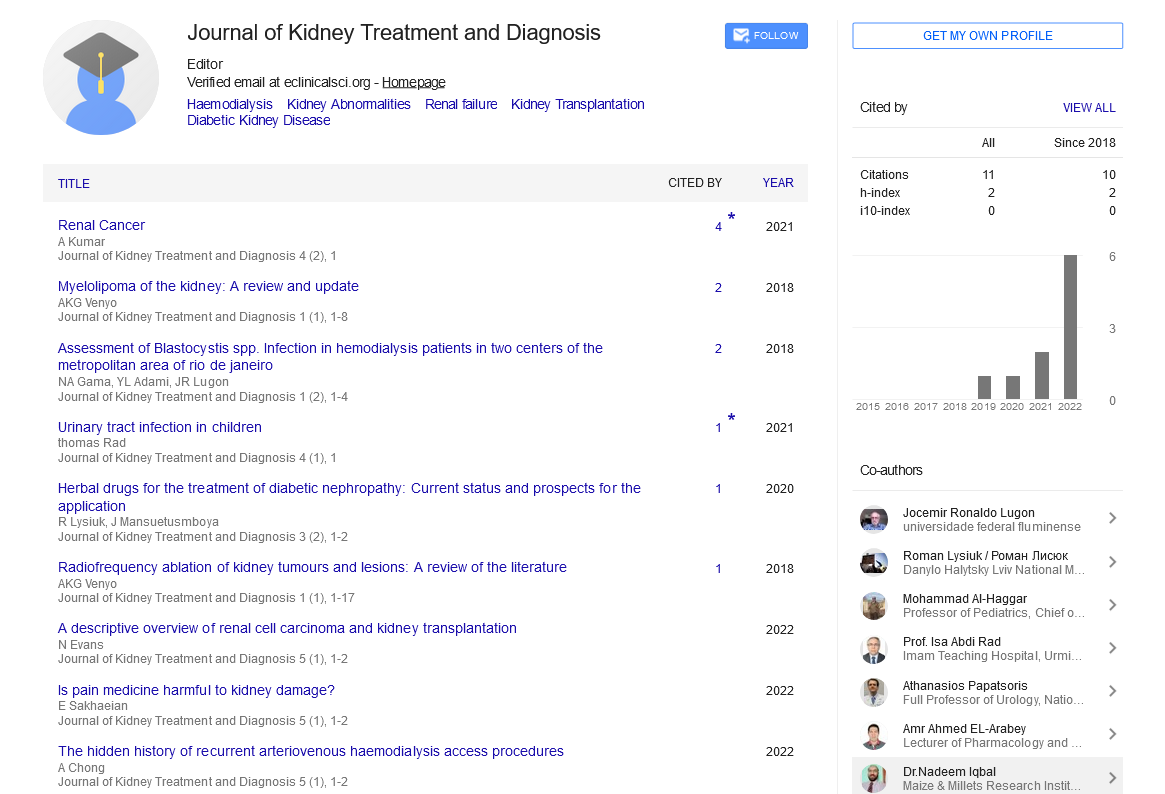Chronic kidney disease and its complications
Received: 01-Jan-2021 Accepted Date: Jan 15, 2021; Published: 22-Jan-2021
Citation: Hassan S. Chronic Kidney disease and its complications. J Kidney Treat Diagn 2021; 4(1):5
This open-access article is distributed under the terms of the Creative Commons Attribution Non-Commercial License (CC BY-NC) (http://creativecommons.org/licenses/by-nc/4.0/), which permits reuse, distribution and reproduction of the article, provided that the original work is properly cited and the reuse is restricted to noncommercial purposes. For commercial reuse, contact reprints@pulsus.com
Description
Chronic kidney disease (CKD) is a major disease affecting more than 20 million individuals. Progression of CKD is associated with a number of serious complications, including increased incidence of hyperlipidemia, anemia, cardiovascular disease and metabolic bone disease. CKD patients should be evaluated for the presence of these complications and receive optimal treatment to decrease their morbidity and mortality. A integrative approach is required to accomplish this goal.
Chronic kidney disease (CKD) is recognized as a primary health problem affecting now-a-days. Chronic kidney disease, also called chronic kidney failure, defines the gradual loss of kidney function. Your kidneys drain wastes and excess fluids from your blood, which are then excreted in your urine. When chronic kidney disease enters into an advanced stage, dangerous levels of fluid, electrolytes and wastes can build up in your body.
Treatment for chronic kidney disease centers on slowing the progression of the kidney damage, usually by controlling the fundamental cause. Chronic kidney disease can progress to end-stage kidney failure, which is lethal without artificial filtering (dialysis) or a kidney transplant. As numbers of CKD patients increase, primary care practitioners will be challenged with management of the complex medical problems unique to patients with chronic renal impairment. As well documented in the literature, until renal replacement therapy is required, the nephrologist rarely manages the medical needs of CKD patients. In this chapter we will define CKD staging and discuss five complications associated with CKD: hyperlipidemia, anemia, osteodystrophy, nutrition and cardiovascular risk. Signs and symptoms of kidney disease are Nausea, Fatigue and weakness, Vomiting, Loss of appetite, Sleep problems, Swelling of feet and ankles, Muscle twitches and cramps, Changes in how much you urinate, Persistent itching, Decreased mental sharpness, Chest pain, if fluid builds up around the lining of the heart, Shortness of breath, if fluid builds up in the lungs, High blood pressure (hypertension) that's difficult to control and many more. Chronic kidney disease develops when a disease or condition impairs kidney function, causing kidney damage to damage over several months or years.
Chronic kidney disease can alter almost every part of your body. Potential complications may include are Fluid retention, which could drive to swelling in your arms and legs, high blood pressure, or fluid in your lungs (pulmonary edema), A sudden rise in potassium levels in your blood (hyperkalemia), which could impair your heart's ability to function and may be life-threatening, Heart and blood vessel (cardiovascular) disease, Weak bones and an increased risk of bone fractures, Anemia, Decreased sex drive, erectile dysfunction or reduced fertility, Damage to your central nervous system, which can cause difficulty concentrating, personality changes or seizures, Decreased immune response, which makes you more vulnerable to infection, Pericarditis, an inflammation of the saclike membrane that envelops your heart (pericardium), Pregnancy complications that carry risks for the mother and the developing fetus, Irreversible damage to your kidneys (end-stage kidney disease), eventually requiring either dialysis or a kidney transplant for survival[1-5].
Conclusion
Chronic kidney disease can alter almost every part of your body. Potential complications may include are Fluid retention, which could drive to swelling in your arms and legs, high blood pressure, or fluid in your lungs (pulmonary edema), A sudden rise in potassium levels in your blood (hyperkalemia), which could impair your heart's ability to function and may be life-threatening, Heart and blood vessel (cardiovascular) disease, Weak bones and an increased risk of bone fractures, Anemia, Decreased sex drive, erectile dysfunction or reduced fertility, Damage to your central nervous system, which can cause difficulty concentrating, personality changes or seizures, Decreased immune response, which makes you more vulnerable to infection, Pericarditis, an inflammation of the saclike membrane that envelops your heart (pericardium), Pregnancy complications that carry risks for the mother and the developing fetus, Irreversible damage to your kidneys (end-stage kidney disease), eventually requiring either dialysis or a kidney transplant for survival.
REFERENCES
- Coresh J, Selvin E, Stevens LA, et al. Prevalence of chronic kidney disease in the United States. Jama-Journal of the American Medical Association. 2007;298:2038-2047.
- Singh AK, Szczech L, Tang KL, et al. Correction of anemia with epoetin alfa in chronic kidney disease. N.Engl.J.Med. 2006;355:2085- 2098.
- Levey AS, Eckardt KU, Tsukamoto Y, et al. Definition and classification of chronic kidney disease: a position statement from Kidney Disease: Improving Global Outcomes (KDIGO) Kidney Int. 2005;67:2089-2100
- Lee GH, Benner D, Regidor DL, et al. Impact of kidney bone disease and its management on survival of patients on dialysis. J Ren Nutr 2007;17:38-44.
- Hsu CY, Vittinghoff E, Lin F, et al. The incidence of end-stage renal disease is increasing faster than the prevalence of chronic renal insufficiency. Ann.Intern.Med. 2004;141-95-101.





